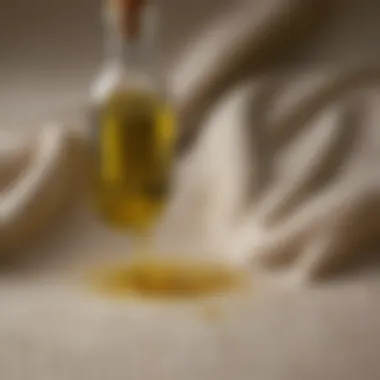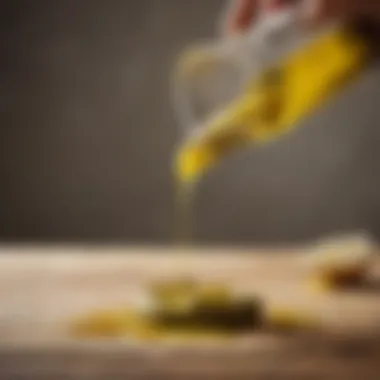Removing Olive Oil Stains: Expert Tips & Techniques


Intro
Olive oil stains are an unfortunate but frequent issue for many individuals. Whether you are a culinary enthusiast or simply enjoy cooking at home, the occasional spill is nearly inevitable. These stains can be particularly vexing due to the oil's nature. Unlike other substances, olive oil can penetrate fabric fibers deeply, making it harder to remove. Understanding the formation of these stains and employing effective removal techniques can greatly improve your laundry outcomes.
This guide aims to provide strategies for eliminating olive oil stains from clothing. By delving into the science behind the stains and suggesting practical solutions, this article is tailored to assist those looking for reliable methods to maintain their garments. Let’s explore this topic further, considering various techniques that can help restore clothes to their original condition.
Understanding Olive Oil Stains
Understanding olive oil stains is essential when it comes to maintaining your clothing. These stains can be quite stubborn, and knowing their nature helps in choosing the right removal methods. Recognizing how olive oil interacts with fabric types can minimize damage and improve cleaning outcomes. Furthermore, grasping the characteristics of olive oil aids in preventing future stains and addressing existing ones effectively.
Composition of Olive Oil
Olive oil is primarily composed of triglycerides, which are fats, and these fats are not water-soluble. This characteristic is key to understanding why olive oil stains cling to fabric. Additionally, olive oil contains essential fatty acids and a small amount of antioxidants and other compounds. This blend not only affects its taste but also its staining properties. For instance, the oleic acid content contributes to the oil's ability to penetrate fibers, making it difficult to remove without proper techniques. Understanding this composition is crucial for devising effective cleaning strategies.
How Stains Form on Fabric
Stains from olive oil formation on fabric begins when the oil comes into contact with the material. Once olive oil seeps into the fabric, it saturates the fibers. The process is exacerbated by heat from skin or cooking surfaces. Unlike water-based stains, which can be lifted more easily, oil stains bind tightly to fibers. The longer the oil stays on the fabric, the harder it becomes to remove. Without prompt action, these stains will settle in, requiring more intensive cleaning efforts. Thus, understanding this dynamic can guide individuals in taking timely actions to reduce the stain's impact.
Common Myths About Olive Oil Stains
Understanding common myths surrounding olive oil stains is essential when addressing this issue effectively. Misinformation can lead to improper stain removal techniques, which may result in permanent damage to fabrics. This section aims to debunk such misconceptions to educate readers and empower them with the right knowledge regarding olive oil stains.
Oil Stains Never Come Out
One prevalent myth is that oil stains, including those from olive oil, are impossible to remove. This belief often causes frustration and a sense of helplessness when individuals encounter such stains. The reality, however, is that while olive oil stains can be challenging, they are not irreversible.
Many successful removal methods are available that can significantly reduce or completely eliminate stains when applied promptly and correctly. These methods include using common household items like dish soap, baking soda, and cornstarch. Each technique addresses the stain's composition in unique ways, effectively breaking down the oil particles. By utilizing these methods, it is entirely plausible to restore garments to their original condition, proving that this myth is more fiction than fact.
Soaking in Water Helps
Another misconception is the belief that soaking a stained garment in water will assist in removing the olive oil stain. In fact, this approach can make the situation worse. Water alone does not have the ability to dissolve oil. When fabric is soaked in water, the olive oil can spread more deeply into the fibers, making it harder to remove.
Instead of soaking, it is better to act quickly and utilize appropriate methods for treating the stain. Applying dish soap directly to the stain or using absorbent materials like baking soda or cornstarch before using water is a more effective strategy. This approach not only helps to absorb the oil but also allows for a cleaner and more effective removal process. Remember, addressing the stain in the right manner is crucial; soaking does not yield the desired results.
Initial Steps to Take When Oil Spills Occur


Removing olive oil stains demands immediate attention. This phase is critical because the potential for effective removal significantly decreases with time. Addressing the spill quickly can prevent the oil from settling deeper into the fibers of the fabric and becoming more challenging to eliminate. This guide aims to empower readers with knowledge about the necessary initial responses to oil spills, highlighting key actions that set the stage for successful stain removal. Failure to act promptly may lead to persistent stains, requiring more extensive cleaning efforts later on.
Immediate Action Required
When an olive oil spill occurs, follow these steps promptly:
- Blot the Stain: Avoid rubbing the stain, as this can spread the oil further. Instead, gently dab the area with a clean cloth or paper towel. This will help absorb excess oil without pushing it deeper into the fibers.
- Remove Excess Oil: If possible, use a spoon or a butter knife to carefully lift off any solidified bits of oil or food, being cautious not to damage the fabric.
- Avoid Water: Contrary to some beliefs, dousing the area with water is not advisable. Water can bind the oil to the fabric, making the stain more difficult to treat. Instead, focus on blotting and absorbing the oil as much as possible.
Acting swiftly after a spill ensures a better chance of restoring your garment to its original condition. Every second counts.
Assessing the Impact of the Spill
After taking immediate action, it's vital to evaluate the impact of the spill on the clothing:
- Determine the Fabric Type: Different fabrics react differently to oil stains. Understanding your garment's material can inform your approach to cleaning it.
- Check the Size of the Stain: A small, localized stain will require a different treatment process than a large one. Identifying the extent of the spill helps in selecting the right method for stain removal.
- Look for Previous Stains: If the garment has existing stains, they might complicate the removal process. Assessing the overall condition of the fabric can guide further steps.
Methods for Olive Oil Stain Removal
Removing olive oil stains is crucial for maintaining the integrity and appearance of clothing. Olive oil is a common ingredient in many kitchens, and accidents happen. Knowing effective methods to remove these stains can save not only your clothes but also time and money. Each method discussed herein provides unique benefits and considerations. The sooner you address the stain, the better your chances of complete removal.
Using Dish Soap
Dish soap is designed to cut through grease. This makes it particularly effective for removing olive oil stains. To use dish soap, apply a small amount directly to the stain. Rub gently with your fingers or a soft cloth. Let it sit for about five minutes. Then rinse with cold water before laundering as usual. This method works well on most fabrics and is readily available in most households.
Tip: Always check the fabric care label to ensure that dish soap will not damage the material.
Employing Baking Soda
Baking soda is an excellent absorbent material. It can help lift the stain from the fabric. Start by sprinkling a generous amount of baking soda over the olive oil stain. Let it sit for about 30 minutes. The baking soda will absorb the oil. Afterwards, brush off the baking soda and wash the garment as you normally would. This method is particularly effective on clothing that allows for a longer soak time without damage.
Utilizing Cornstarch
Cornstarch functions similarly to baking soda. It absorbs oils effectively. To use cornstarch, sprinkle a layer on the stain and let it sit for 15-20 minutes. Afterward, shake off the excess powder. It may also help to gently brush the fabric with a soft brush to dislodge any remaining residue. Wash the item according to its care instructions after treating it with cornstarch.
Commercial Stain Removers


There are several commercial stain removers designed specifically for oil stains. These products often contain powerful degreasers. It is best to follow the instructions provided by the manufacturer. First, apply the product to the stain and allow it to penetrate for the recommended time. Rinse and then launder as directed. Although these products are effective, they may contain chemicals that can cause discoloration on some fabrics.
When addressing olive oil stains, each method has its own merits. The choice of technique may depend on the fabric type, available materials, and personal preference. Experimentation may be necessary to find the most effective solution for specific stains.
Special Considerations for Different Fabrics
When addressing olive oil stains, it is crucial to recognize that not all fabrics respond uniformly to stain removal methods. Each fabric type has unique properties that require tailored approaches. Understanding how different materials react to oil spills can help in minimizing damage and enhancing the effectiveness of the cleaning process.
Cotton Garments
Cotton is one of the most common fabrics found in our wardrobes. Its breathable nature and durability make it a favorite for everyday wear. When it comes to olive oil stains, acting promptly is critical.
- Blot the stain gently using a clean cloth to absorb excess oil.
- Apply a dish soap solution, which can cut through the grease effectively. Mix one part dish soap with two parts warm water.
- Rinse thoroughly to remove all soap remnants.
- If the stain persists, consider using baking soda as a gentle abrasive. Sprinkle it onto the stain and let it sit for about 15 minutes before washing.
Caution: Avoid high heat when drying, as it can set the stain.
Wool and Delicate Fabrics
Wool and other delicate fabrics, such as silk, require a more cautious approach due to their sensitive structures. The goal is to avoid any harsh treatments that could result in fiber damage or shrinkage.
- Start by using a paper towel to blot rather than rub, preventing fibers from becoming matted.
- For wool, dampen a cloth with cool water and apply a small amount of mild detergent. Apply gently on the stain.
- Rinse out the detergent carefully, ensuring that no residue remains.
- Air drying is essential for these materials, as heat can alter their shape and texture.
Important Note: Professional dry cleaning may be your best option for serious stains on delicate fabrics.
Synthetic Materials
Synthetic fabrics, such as polyester and nylon, are often more resilient than natural fibers. However, they can also be prone to staining if not treated correctly.
- Blot the stain immediately to soak up excess oil.
- A combination of warm water and a synthetic-friendly detergent usually works effectively. Apply the solution directly onto the stain and let it sit for around 10 minutes.
- Machine wash on a suitable cycle while paying attention to the care label for temperature settings.
- Always verify that the stain is gone before drying, as heat can finalize the stain.
Understanding these specific considerations is essential to proper care and maintenance of your garments. Tailored approaches for each fabric type will not only help in successfully removing olive oil stains but will also prolong the life of your clothing.
Prevention of Olive Oil Stains
Preventing olive oil stains is crucial for maintaining the longevity and appearance of your clothing. Understanding how to minimize the risk of spills can save both time and effort in stain removal. Many cooking activities naturally involve olive oil, making it more important to adopt precautions that lessen the likelihood of such mishaps. By focusing on safe cooking practices and wearing protective clothing, individuals can enjoy cooking without the fear of damaging their garments.


Safe Cooking Practices
Implementing safe cooking practices is a key strategy for avoiding olive oil stains. Here are some practical recommendations:
- Stabilize Cooking Conditions: Always ensure that containers holding olive oil are secure. Use oil dispensers that lessen the chance of accidental spills.
- Control the Heat: Avoid high heat settings that cause oil to splatter. Medium to low flames allow for greater control and minimize erratic splashes.
- Use Proper Utensils: Employ utensils that help prevent oil from spilling. For instance, a ladle can be more effective than using a spoon directly from the container.
- Limit Movement: While cooking, limit unnecessary movement across the kitchen. A steady work area decreases the chance of brushing against garments that may come into contact with oil.
By following these practices, you not only secure your clothing but also create a safer cooking environment overall. The less oil you have outside the pan, the less likely it will land on your clothes.
Protective Clothing Recommendations
Wearing appropriate protective clothing is another line of defense against olive oil stains. Consider these suggestions to protect your garments:
- Invest in Aprons: A durable, spill-resistant apron can provide a barrier between you and any accidental splashes. Choose materials such as cotton or polyester blends for easy cleaning.
- Select Dark or Patterned Fabrics: Choosing darker clothing or garments with busy patterns can help conceal minor stains, making the cleaning process less daunting.
- Avoid Loose Fitting Clothes: Loose clothing can easily brush against surfaces, making it more likely to be stained by oil. Opt for more fitted options that stay close to the body.
- Designate Cooking Attire: Consider designating specific clothing for cooking. These garments may be less precious and can handle a bit more mess compared to your everyday wear.
Taking these preventive measures will greatly reduce the chances of dealing with stubborn olive oil stains. It is about being proactive rather than reactive, ensuring you can enjoy your culinary adventures with less worry about your wardrobe.
"An ounce of prevention is worth a pound of cure." This is particularly true in the context of shielding your clothing from unavoidable kitchen environments.
Additional Resources and Tips
The topic of removing olive oil stains from clothing encompasses many layers of knowledge and practice. It is vital to understand that despite the comprehensive techniques covered, situations may arise that require further support or intervention. Therefore, including additional resources and tips can substantially enhance one’s ability to address these kinds of stains effectively.
When to Seek Professional Help
Occasionally, olive oil stains may resist home remedies due to several reasons. These include the type of fabric, the duration of the stain, or the severity of the spill. Losing a favorite garment can be frustrating, especially if it has sentimental value.
Knowing when to seek professional help becomes essential. Consider the following signs:
- The stain does not respond after multiple treatments.
- The fabric is labeled as dry clean only.
- The stain has lingered for an extended time.
In such cases, professional dry cleaners have access to specialized products and techniques designed for stubborn stains. They can offer a thorough assessment and treatment plan tailored to the garment’s needs.
Maintaining a Stain-Free Wardrobe
Preventive measures can be as important as stain removal strategies. Adopting simple habits can vastly reduce the chances of olive oil stains occurring. Here are some practical tips to help maintain a stain-free wardrobe:
- Be Mindful While Cooking: Simple strategies, such as using a splatter guard, can help minimize accidents.
- Wear Protective Layers: Invest in aprons or other protective clothing when cooking to shield your outfits from grease.
- Immediate Cleanup: In the event of a spill, quickly blot the area with a clean cloth instead of rubbing it, to absorb excess oil.
By implementing these guidelines, you can help ensure that your garments remain in good condition, allowing you to focus on your culinary pursuits without the added concern of potential stains.
Remember, maintaining a proactive approach not only helps in keeping clothes clean, but it also extends the life of your favorite items.
Consulting resources like Wikipedia or Britannica can provide further insights into fabric care and stain management. Engage with communities on Reddit to share tips or seek advice from others who have faced similar challenges.







